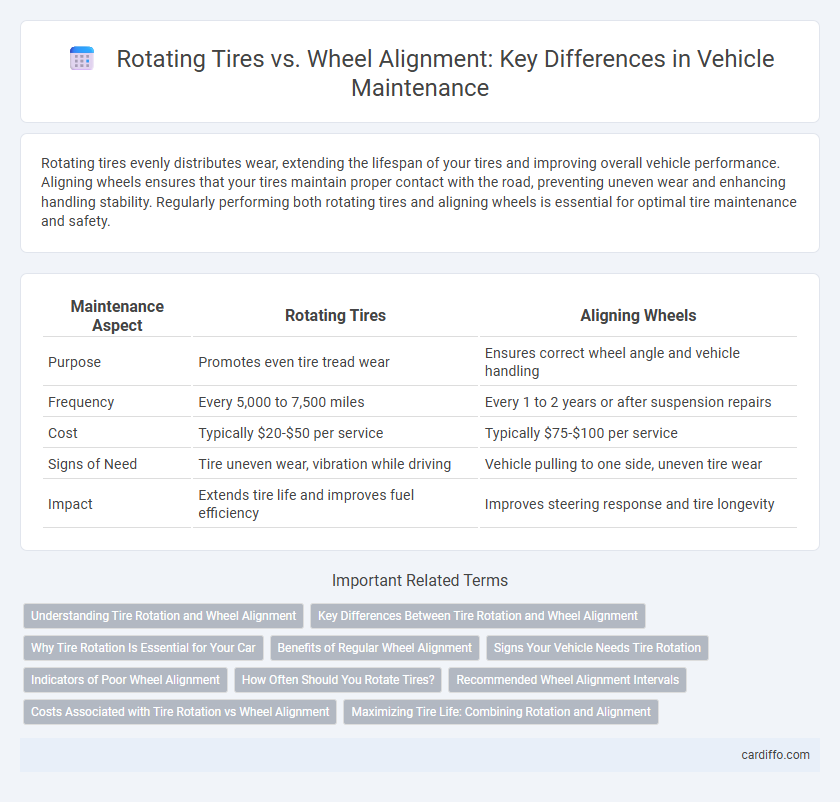Rotating tires evenly distributes wear, extending the lifespan of your tires and improving overall vehicle performance. Aligning wheels ensures that your tires maintain proper contact with the road, preventing uneven wear and enhancing handling stability. Regularly performing both rotating tires and aligning wheels is essential for optimal tire maintenance and safety.
Table of Comparison
| Maintenance Aspect | Rotating Tires | Aligning Wheels |
|---|---|---|
| Purpose | Promotes even tire tread wear | Ensures correct wheel angle and vehicle handling |
| Frequency | Every 5,000 to 7,500 miles | Every 1 to 2 years or after suspension repairs |
| Cost | Typically $20-$50 per service | Typically $75-$100 per service |
| Signs of Need | Tire uneven wear, vibration while driving | Vehicle pulling to one side, uneven tire wear |
| Impact | Extends tire life and improves fuel efficiency | Improves steering response and tire longevity |
Understanding Tire Rotation and Wheel Alignment
Tire rotation involves periodically changing the position of tires on a vehicle to ensure even tread wear and extend tire lifespan, typically recommended every 5,000 to 8,000 miles. Wheel alignment adjusts the angles of the wheels to the manufacturer's specifications, preventing uneven tire wear, improving handling, and enhancing fuel efficiency. Proper tire rotation combined with regular wheel alignment helps maintain optimal vehicle performance, safety, and tire durability.
Key Differences Between Tire Rotation and Wheel Alignment
Tire rotation involves moving tires from one position on the vehicle to another to ensure even tread wear and extend tire lifespan, typically recommended every 6,000 to 8,000 miles. Wheel alignment adjusts the angles of the wheels, including camber, toe, and caster, to ensure proper contact with the road, prevent uneven tire wear, and improve handling stability. While tire rotation focuses on tire preservation, wheel alignment addresses suspension and steering geometry issues for optimal vehicle performance and safety.
Why Tire Rotation Is Essential for Your Car
Tire rotation is essential for your car because it ensures even tread wear, prolonging the life of your tires and improving fuel efficiency. Regularly rotating tires every 5,000 to 8,000 miles helps maintain balanced traction and handling, reducing the risk of uneven wear that can cause vibrations or unsafe driving conditions. Proper tire maintenance through rotation supports optimal vehicle performance and enhances safety on the road.
Benefits of Regular Wheel Alignment
Regular wheel alignment improves tire lifespan by ensuring even tread wear, reducing the need for frequent replacements and saving costs. Proper alignment enhances vehicle handling and safety, promoting better steering response and minimizing vibrations or pulling to one side. Consistent alignment also increases fuel efficiency by lowering rolling resistance, making it an essential maintenance practice for optimal vehicle performance.
Signs Your Vehicle Needs Tire Rotation
Uneven tire wear, such as bald spots or tread wearing faster on one side, signals the need for tire rotation to balance wear patterns and extend tire lifespan. Vibrations or unusual noises while driving can indicate tires rotating out of sync, necessitating a rotation to restore smooth performance. Regular tire rotation every 5,000 to 7,500 miles helps maintain consistent traction, improves fuel efficiency, and prevents premature tire damage.
Indicators of Poor Wheel Alignment
Uneven tire wear, such as excessive wear on the inner or outer edges, is a primary indicator of poor wheel alignment. Vehicles pulling to one side or a crooked steering wheel while driving straight also signal misalignment issues. Vibration or wobbling at higher speeds can further indicate the need for wheel alignment rather than just tire rotation.
How Often Should You Rotate Tires?
Tires should generally be rotated every 5,000 to 7,500 miles to ensure even wear and extend their lifespan. Regular rotation prevents uneven tread wear caused by the varying forces on front and rear tires, optimizing vehicle handling and safety. Following the vehicle manufacturer's recommendations and inspecting tire tread depth during rotations can further enhance maintenance effectiveness.
Recommended Wheel Alignment Intervals
Recommended wheel alignment intervals typically range between 10,000 to 12,000 miles or once a year to maintain vehicle handling and tire wear. Wheel alignment should be checked after rotating tires, as uneven wear or road conditions can cause misalignment. Proper alignment ensures optimal tire life, fuel efficiency, and safety, reducing the risk of uneven tread wear and steering issues.
Costs Associated with Tire Rotation vs Wheel Alignment
Tire rotation typically costs between $20 and $50, helping to extend tire life by promoting even wear. Wheel alignment services range from $75 to $100 but are crucial for correcting uneven tire wear and improving vehicle handling. Regular tire rotation reduces the frequency of costly alignments, optimizing long-term maintenance expenses.
Maximizing Tire Life: Combining Rotation and Alignment
Maximizing tire life requires a strategic approach that combines both rotating tires and aligning wheels. Regular tire rotation ensures even tread wear across all tires, while precise wheel alignment prevents uneven pressure and premature tire damage. Together, these maintenance practices extend tire durability, improve vehicle handling, and enhance fuel efficiency.
Rotating Tires vs Aligning Wheels Infographic

 cardiffo.com
cardiffo.com